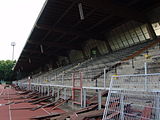Gruga Stadium
| Gruga Stadium | |
|---|---|

|
|
| Gruga Stadium during the 2001 demolition | |
| Data | |
| place |
|
| Coordinates | 51 ° 25 '28.6 " N , 6 ° 59' 41.3" E |
| owner | City of Essen |
| start of building | 1961 |
| opening | September 13, 1963 |
| demolition | 2001 |
| surface | Natural grass |
| architect | Ulrich Schmidt von Altenstadt, Ernst von Rudloff, Eckhard Schulze-Fielitz |
| capacity | 40,000 seats |
| Events | |
The Gruga Stadium in the Rüttenscheid district was one of the largest sports stadiums in Essen from 1963 until it was demolished in 2001 . It was part of a sports facility consisting of a stadium, gymnasium and festival meadow, which functionally matched the Grugabad , which was also built between 1961 and 1963 .
history
Already in the Third Reich there were plans to build a sports stadium near the Gruga and Messe Essen , which would have become one of the largest stadiums in Germany. An old brick factory and the associated clay pit in the Moritzstrasse / Verbandstrasse area in Essen-Rüttenscheid were intended for this purpose. The site, also known as the Monday Hole , was used as a large rubble dump after World War II . The history of the Third Reich meant that the stadium did not get beyond the shell.
The Gruga Stadium, begun in 1961, was suitable for athletics events and football games. It was opened on September 13, 1963 with the north-western main grandstand and offered around 40,000 seats. For the German Gymnastics Festival in 1963 , a new sports facility was built, which included a multi-purpose sports hall to the northeast of the stadium and a large festival meadow to the east of the stadium surrounded by earthen walls with spectator stands. The entire site took up an area of 12.4 hectares.
In September 1971, the international final of the TV game show Games Without Borders took place in the Gruga Stadium.
However, there was no need for a third large stadium in Essen, as the two top-performing football clubs Schwarz-Weiß Essen and Rot-Weiss Essen preferred their traditional venues. Only between 1974 and 1978 was the Grugastadion used by Schwarz-Weiß Essen for games in the second Bundesliga North, as the city of Essen did not restore the Uhlenkrugstadion, which had only recently been taken over by the club, to a condition suitable for the second division . In addition, during the renovation of the Georg Melches Stadium at the end of the 1990s, the stadium was used as an alternative location by the then top division club Rot-Weiss Essen. The only club that felt the stadium as a home stadium was therefore from 1991 until the demolition of the Assindia Cardinals football club . In addition, the stadium was used by schools for sports festivals, which together was not enough to maintain it. The budget situation of the city of Essen had led to renovation residues, and the area of the gymnasium had come into focus of the expanding Messe Essen , which needed more parking spaces.
After the fairground, which was converted into three adjacent soccer fields (two ashes and one grass pitch) after the gymnastics festival, and two of the squares were made into asphalt parking spaces for the trade fair in the 1980s, the Grugastadion in 2001 and the gymnastics hall in 2002 tore off. In October 2007, the groundbreaking ceremony for the new E.ON Ruhrgas headquarters, which opened in October 2010, took place on the site of the Gruga Stadium. In the area of the two other sports facilities, a Hochtief administration building and residential development were built.
gallery
Web links
- europlan-online.de: picture gallery
Individual evidence
- ↑ Essen.de: Press release from September 16, 2011 - 40 years ago: “Games without borders” from Essen ; last viewed on January 30, 2014


